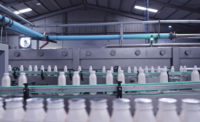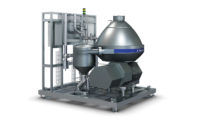Leveraging packaging and processing technologies that enhance food safety while reducing waste is vital if processors are to enhance efficiencies while operating in a more sustainable manner.
The growing importance of such measures is triggering greater interest from dairy processors in aseptic and extended shelf-life packaging and equipment.
Aseptic packaging is the process by which microorganisms are kept from entering containers during and after packaging. The process involves the sterilization of food and beverages by quick exposure to ultra-high heat, rapid cooling to an ambient temperature, and filling into sterilized packages that are then sealed in a commercially sterile environment.
The U.S. Department of Agriculture (USDA) reports that aseptic packaging was introduced in the U.S. in the early 1980s following its development in Europe to assist the World Health Organization in providing beverages to disaster victims. Aseptically packaged dairy products include milk, liquid eggs and whipping cream.
“There are no health concerns associated with aseptic packaging,” the USDA states, noting that an inside layer of polyethylene (plastic) touches the product without leaching of aluminum or aluminum components through the layer.
Aseptic packages are typically a mix of paper (70%), low density polyethylene (24%), and aluminum (6%), notes Precision Reports, a Maharashtra, India.-based market research firm, which projects steady market growth through 2031. “Together, these materials form a tight seal against microbiological organisms, contaminants, and degradation, eliminating the need for refrigeration,” Precision Reports states.
ESL is A-OK
In addition to aseptic, extended shelf life (ESL) packaging and processing is designed to lengthen the shelf life of a chilled distributed product beyond those of a conventionally pasteurized item, states Tetra Pak International S.A., a Lausanne, Switzerland-based provider of food processing and packaging solutions, in a white paper on extending the shelf life of chilled milk.

As distribution areas expand, ESL is important for ensuring that milk and other liquids remain fresh and maintain the necessary shelf life after arrival at destinations, Tetra Pak states.
The hygiene level of filling machines and the package material will affect the microbiological shelf life of dairy products, Tetra Pak reports. The supplier notes that a combination of hydrogen peroxide spray and high-energy UV light is the prevailing method for disinfecting or sterilizing packages.
“This is supplemented by blowing in HEPA-filtered air, which prevents other air from entering and enables all filling and sealing operations to be performed in a high-hygiene environment,” Tetra Pak states.
Packaging material must also protect against such elements as oxygen and light, the supplier notes. “All milk products are sensitive to light, requiring a light barrier to prevent nutritional and sensory degradation,” Tetra Pak reports.
Maintaining package integrity is important as well for avoiding post-packaging bacterial contamination that might occur in sealed containers, even without any visible leakage, Tetra Pak states, noting that it is critical to protect such areas as seals, creases and openings.

“The mechanical stability (sturdiness) of an ESL package is also important, since it will be stored and distributed in cold and humid conditions for extended periods,” Tetra Pak explains. “Secondary packaging should be made of materials permeable to moisture in order to prevent the formation of a highly humid microclimate close to the package.”
Supply chain enhancements
Extended shelf life and aseptic processes are becoming increasingly popular as dairy processors seek to keep pace in an increasingly competitive market, says David Miles, executive vice president of MicroThermics Inc., a Raleigh, N.C.-based provider of pasteurizing and sterilization technologies, including aseptic processors and high-temperature short-time (HTST) and ultra-high temperature (UHT) designs.
“These processes extend the time over which companies can sell their products, which enables them to extend the geographic market while reducing loss due to spoilage,” he states.
The prospect of lower supply chain costs also is generating greater interest in aseptic and ESL packaging, says Dan Margherio, business development manager for IMA Dairy & Food USA, a Leominster, Mass.-based supplier of packaging technologies. Users of the equipment, he notes, can transport many aseptic dairy items via non-refrigerated distribution channels, which requires less energy and leads to lower operating expenses.

“The chilled distribution chain also is less established or developed in some areas, including Mexico and Central America,” Margherio says. “Distributing at ambient temperature can be a must for producers seeking to reach more consumers, especially those in remote areas.”
In addition, aseptic technologies can help dairy manufacturers reduce their carbon footprint by eliminating the need for refrigerated distribution, says Tucker Scofield, packaging sales manager — beverage, North America, for GEA Group Aktiengesellschaft, a Düsseldorf, Germany-based provider of dairy packaging and processing systems. “This reduces dependence on cold chain logistics and energy consumption,” he states, adding that extended shelf life and aseptic packages also help mitigate waste from products going out of date.
An expensive proposition
While aseptic packaging enables processors to extend product shelf life without the need for preservatives and other ingredients, it can be a costly and challenging process. Aseptic packaging also is not ideal for all dairy items, including those with particulates, says Julian Stauffer, CEO of Waldner North America, a Wichita, Kan.-based developer of packaging machinery.
He states, for instance, that it can cost one-and-a-half to three times more to leverage aseptic or ESL packaging equipment versus conventional technologies, depending on the degree of sterilization.
“It is expensive to maintain a sterile production environment and cross-contamination in a facility can cause problems,” Stauffer says. “This additional cost will reflect the final product price and consumers are not necessarily willing to pay more.”
Stauffer adds, however, that processors can often justify the extra investment if products are successful, or market research indicates potential success.
Operators, meanwhile, can potentially lower investment costs by contracting with an aseptic co-packer to run the company’s selections in the vendor’s aseptic packaging facility, Stauffer says. “Companies can trial-run new products with customers and, as the product grows, the company can continue with the co-packer or decide to bring the new items in-house,” he states.
A key processor aim should be to leverage equipment that provides line versatility and enables the operator to quickly change between bottle formats and products, Scofield says, stating that such technologies also must permit swift cleaning.
Margherio adds, however, that aseptic solutions are “typically less flexible in size and format scope, so meeting a wide range of aseptic packaging needs means investing in several lines.”
Adopting the relevant ESL processes also can be vexing. For instance, despite the benefits from eradicating microorganisms, it is vital for yogurt developers to maintain certain bacteria cultures which operate as probiotics. Exposing yogurts to heat treatment, however, can deactivate the bacteria inherent in it, Margherio says, “Which means ambient distribution in this category should typically be limited to ‘yogurt flavored’ products.”
In addition, aseptic processing is typically not suitable for white milk because of the resulting cooked flavor, Miles says. “For traditional white milk, the consumer prefers a light flavor,” he notes.

Aseptic processors also must overcome the false stigma that it can be difficult to maintain sterility with aseptic packaging; that many hours of production are lost reestablishing sterility; and that the procedure can be excessively expensive, Schoefield says.
“This perception is primarily based upon the experiences of first-generation aseptic equipment that consumed large quantities of water and peracetic acid and was costly,” he states, adding that newer designs are more efficient and effective.
A changing landscape
Such enhancements to aseptic and ESL packaging and processes include designs with smaller footprints that enable higher-speed production and easier operation, Margherio says.
Aseptic carton technologies also are enabling greater output while enhancing sustainability by allowing operators to replace aluminum foil barriers with more eco-friendly materials while replacing peroxide cleaning with UV to promote a more circular economy, he states.
Additional packaging styles, such as plastic bottles, are becoming more prominent for ESL products as well, Miles says. “These items have a perception of being higher quality and are more recyclable,” he notes.
For the most effective systems, it is essential that the storage and distribution chain for ESL dairy selections operate with the optimal temperatures, Tetra Pak states, noting that temperatures over 46 degrees Fahrenheit will accelerate the deterioration process and enable microbial growth.
“The preservation of ESL products is fully dependent on low-temperature distribution,” Tetra Pak notes, adding that a typical distribution chain in the U.S. is about 44.6 degrees Fahrenheit. “If such a chain is not possible, there is one more solution available: UHT and aseptic processing,” the supplier states.
Many users of ESL systems are not seeking to achieve sterility, but to extend shelf life by minimizing spoilage from microbial growth, Stauffer states. Yogurt cups, for instance, can burst if spoilage-causing bacteria is present in the cups prior to the addition of yogurt’s already beneficial bacteria. That makes it essential for operators to incorporate sterile cups and lids so the microbial loads remain constant, he explains.
“Some applications may be more cost-effective with a certain process, while others are a better fit for the product, package or operating environment,” Stauffer concludes. “In the end, regardless of the chosen processing method, hermetically sealed packaging is the final barrier to minimizing a food product’s risk of encountering microorganisms and spoilage.”



